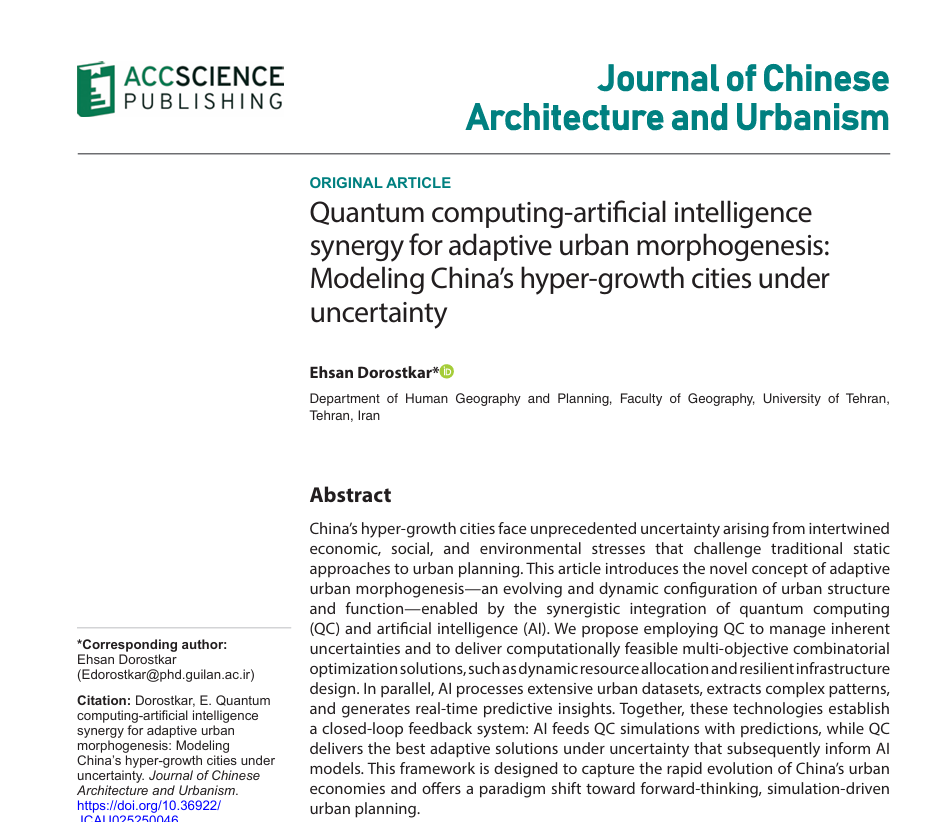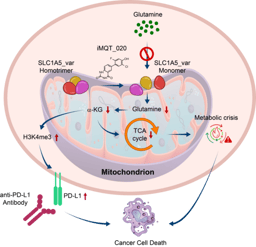Forging the Future of Cities: How Quantum Computing and AI Can Guide China's Hyper-Growth
Published in Earth & Environment

The story of China’s urban transformation is one of the most remarkable of our time. Megacities have risen at an unprecedented pace, fueling economic growth and lifting millions out of poverty. Yet, this hyper-growth comes with a double-edged sword: immense strains on infrastructure, resources, and the environment, all operating within a web of deep uncertainty.
Traditional urban planning, with its static models and deterministic forecasts, is struggling to keep up. It often reacts to crises rather than anticipating them. In our latest research published in the Journal of Chinese Architecture and Urbanism, we propose a new paradigm: Adaptive Urban Morphogenesis (AUM). This concept reframes city growth as a dynamic, self-organizing process, much like biological systems, and it's powered by a revolutionary partnership between Quantum Computing (QC) and Artificial Intelligence (AI).
Why China's Cities are the Perfect Testbed
While the principles of AUM could apply to many urban contexts, China’s hyper-growth cities present a uniquely powerful case study. Their unparalleled speed of development creates intense, interconnected challenges. Furthermore, the widespread deployment of Internet of Things (IoT) sensors in its smart cities provides the real-time data needed to fuel this system. The centralized nature of governance also offers a potential pathway for the integrated, cross-departmental data sharing that AUM requires.
The QC-AI Synergy: A Game-Changer for Urban Planning
So, how does this synergy work? Think of it as a closed-loop, cybernetic system for city management:
-
AI as the City's Sense Organs and Cortex: AI processes vast, real-time data streams—from traffic and energy use to social media sentiment and economic metrics—to create a living "digital twin" of the city. It identifies complex patterns and generates probabilistic predictions about future urban states, such as economic shifts or pollution spread.
-
QC as the Strategic Decision Engine: This is where quantum computing comes in. The probabilistic predictions from AI are fed into QC algorithms. QC excels where classical computers falter: solving immensely complex combinatorial optimization problems under extreme uncertainty. It can run sophisticated simulations to find optimal solutions for dilemmas like:
-
Allocating land use to simultaneously maximize economic growth, achieve carbon neutrality, and ensure housing affordability.
-
Dynamically re-routing thousands of shipping containers in a port like Shanghai based on real-time ship arrivals, truck availability, and trade policies.
-
-
The Adaptive Loop: The quantum-optimized solutions inform adaptive policies—like dynamic congestion pricing zones or flexible zoning laws. The system then monitors the real-world impact of these decisions, feeding the results back to refine the AI models and QC algorithms, creating a continuously learning and evolving planning process.
Transformative Potential: From Theory to Practice
This framework isn't just theoretical; it has concrete, transformative applications:
-
Logistics Resilience: Dynamically optimizing Shanghai’s entire supply chain network could reduce costs by 12-18% while boosting reliability and cutting emissions.
-
Spatial Economics: Simulating the land-value impact of new high-speed rail lines under dozens of scenarios to recommend tailored development incentives that prevent speculation and promote equity.
-
Climate Adaptation: Designing optimized portfolios of physical infrastructure (e.g., seawalls) and financial instruments (e.g., catastrophe bonds) to build cost-effective resilience against flooding in coastal megacities like Shenzhen.
-
Algorithmic Governance: Enabling near real-time adaptation, such as automatically adjusting building permit processes in response to AI-identified material shortages or recalibrating public transit subsidies based on QC-optimized mobility patterns.
The Road Ahead: Challenges and Next Steps
Of course, this future is not without its hurdles. Current quantum hardware is still in its noisy, intermediate-scale stage, lacking the fault tolerance for city-scale missions. The massive energy demands of QC also pose a conflict with sustainability goals. Furthermore, we must navigate critical governance and ethical issues, such as preventing algorithmic bias and ensuring democratic oversight and transparency in automated decision-making.
The path forward requires interdisciplinary research into hybrid quantum-classical algorithms, robust data governance, and new validation platforms. A key strategy is to launch pilot projects in controlled environments like the Xiong’an New Area, where the model's robustness, governance structures, and ethical safeguards can be rigorously tested and refined.
By embracing the synergy of QC and AI, we can transform urban planning from a reactive discipline into a proactive, adaptive force. This approach has the potential to turn the inherent volatility of hyper-growth into a competitive advantage, guiding the development of cities that are not only more efficient and wealthy but also more resilient, sustainable, and equitable for all.
This blog post is based on the original research article:
Dorostkar, E. Quantum computing-artificial intelligence synergy for adaptive urban morphogenesis: Modeling China’s hyper-growth cities under uncertainty. Journal of Chinese Architecture and Urbanism (2025). https://doi.org/10.36922/JCAU025250046


Please sign in or register for FREE
If you are a registered user on Research Communities by Springer Nature, please sign in